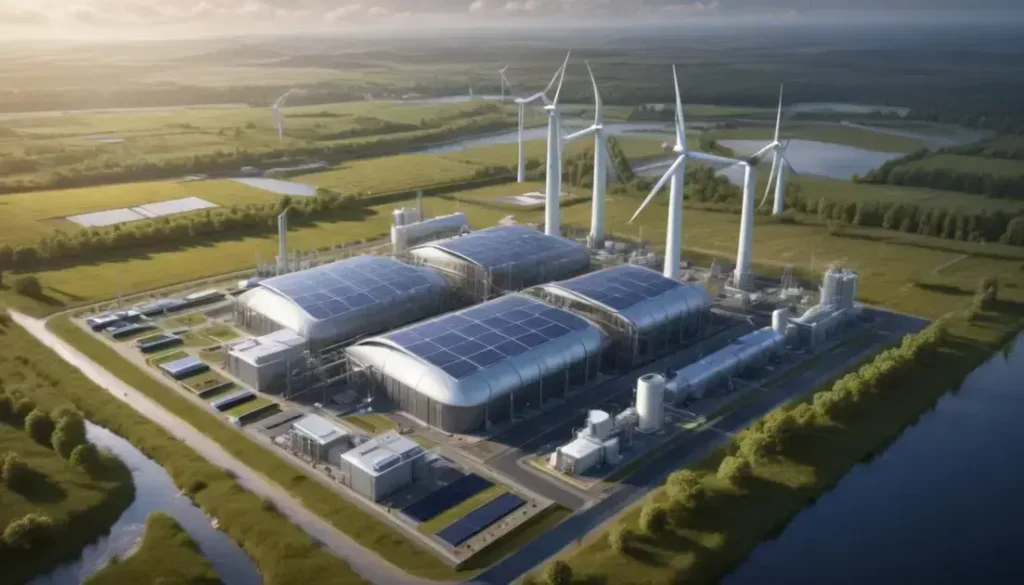Hydrogen aviation represents a sustainable advancement in air travel, significantly reducing greenhouse gas emissions by using hydrogen fuel cells, while offering challenges in production, storage, and regulatory infrastructure.
In a groundbreaking moment for aviation, Hydrogen technology has made its debut with the first piloted helicopter flight. This milestone could reshape how we think about sustainable air travel and its implications.
Overview of hydrogen aviation technology
Hydrogen aviation technology is at the forefront of a revolution in sustainable air travel. This innovative approach uses hydrogen fuel cells to power aircraft, offering a cleaner alternative to traditional fossil fuels. A remarkable aspect of this technology is its potential to significantly reduce greenhouse gas emissions, making air travel more environmentally friendly.
The essence of hydrogen aviation lies in its ability to harness the energy from hydrogen, which, when used as fuel, produces only water vapor as a byproduct. This means that hydrogen-powered aircraft can operate without contributing to air pollution, providing a compelling case for adoption in the aviation industry.
Currently, several companies are actively developing hydrogen aircraft prototypes. They are exploring various designs and technologies to ensure safety and efficiency. These advancements signify a collaborative effort within the industry to meet sustainability goals set forth in global agreements.
Investments in hydrogen technology are increasing, supported by governmental initiatives and private sector funding. This funding is crucial for accelerating research and development, aiming to bring hydrogen-powered flights to commercial viability in the near future. As such, the potential for transforming the aviation sector with hydrogen technology is both exciting and necessary.
First piloted hydrogen helicopter flight
The first piloted hydrogen helicopter flight marks a significant milestone in the journey towards sustainable aviation. This groundbreaking event showcases how hydrogen fuel technology can transform the aviation industry by reducing emissions and promoting eco-friendly operations. The demonstration flight utilized state-of-the-art technology to harness hydrogen energy for propulsion.
During this flight, the helicopter operated seamlessly, demonstrating not only its potential for commercial use but also the efficacy of hydrogen as a viable alternative to conventional fuels. As the helicopter took to the skies, industry experts highlighted its role in paving the way for a future where air travel can be both efficient and environmentally responsible.
The innovation behind the hydrogen helicopter involves complex engineering and rigorous safety protocols, ensuring that all operational aspects are thoroughly vetted. Collaborations between aviation companies and technology developers have been critical in achieving this milestone.
Furthermore, this historic flight serves as a beacon for future investments in hydrogen aviation. It encourages further research and development to explore additional applications of hydrogen technology within various sectors. As nations strive to meet sustainability targets, the success of the hydrogen helicopter could accelerate the shift towards cleaner aviation technologies.
Collaboration between Unither and Robinson
The collaboration between Unither Technologies and Robinson Helicopter Company signifies a pivotal step in the advancement of hydrogen aviation technology. By combining their expertise, both companies aim to innovate and bring sustainable aviation solutions to the forefront of the industry. Unither specializes in developing hydrogen fuel systems, while Robinson is renowned for its excellence in helicopter manufacturing.
This partnership focuses on creating a hydrogen-powered helicopter that leverages cutting-edge fuel cell technology. The goal is to enhance performance while achieving significant reductions in emissions, aligning with global sustainability goals. Collaborative efforts include extensive research and development, where teams work closely to address engineering challenges and ensure the aircraft’s safety and efficiency.
Moreover, the collaboration aims to set new standards within the aviation sector, proving that hydrogen technology can be both practical and viable. By testing prototypes and sharing results, Unither and Robinson can contribute valuable insights to other companies exploring similar paths.
As the world moves towards greener technologies, this partnership could pave the way for more efficient, environmentally friendly air travel options. It also underscores the importance of cooperation in driving innovation and fulfilling the urgent need for sustainable practices in the aviation industry.
Technical details of the hydrogen powertrain
The technical foundation of a hydrogen powertrain plays a crucial role in advancing sustainable aviation. This system primarily consists of hydrogen fuel cells, which convert hydrogen into electricity, powering electric motors that drive the aircraft. Using hydrogen as a fuel source greatly reduces the carbon footprint compared to conventional aviation fuels.
One major component of the hydrogen powertrain is the storage system for hydrogen fuel. This system must ensure that hydrogen is stored safely and efficiently, often requiring high-pressure tanks or cryogenic storage methods to maintain optimal conditions. Advances in tank design contribute significantly to the range and safety of hydrogen-powered aircraft.
Additionally, the fuel cell technology used in these powertrains involves sophisticated processes, including the management of thermal dynamics and energy efficiency. The architecture is designed to maximize the conversion of hydrogen to electricity while minimizing energy loss. Efficient thermal management is essential to keep the fuel cells operating at peak performance.
Moreover, integrating these systems into existing airframes poses several engineering challenges that require innovative solutions. Collaboration between aerospace engineers and hydrogen technology experts is vital to develop systems that meet safety, performance, and regulatory standards.
Benefits of hydrogen fuel cells
Hydrogen fuel cells offer a range of benefits that make them an attractive option for sustainable aviation. One of the primary advantages is their ability to produce zero emissions, as the only byproduct of the chemical reaction is water vapor. This feature positions hydrogen fuel cells as a vital solution in the quest to minimize the aviation industry’s environmental impact.
Another significant benefit is their high energy efficiency. Hydrogen fuel cells convert chemical energy directly into electrical energy, resulting in more efficient energy use compared to traditional combustion engines. This efficiency not only enhances aircraft performance but also allows for a greater range of operations.
Additionally, hydrogen fuel cells can be refueled quickly, similar to conventional fuel systems. This refueling capability is essential for maintaining operational schedules and minimizing downtime for aircraft fleets. The infrastructure for hydrogen refueling is rapidly developing, supporting the integration of this technology into existing aviation frameworks.
Furthermore, hydrogen can be produced from various renewable sources, such as wind and solar energy, making it a versatile and sustainable energy carrier. As the technology matures, the potential for reducing reliance on fossil fuels becomes increasingly feasible, driving innovation in the aviation sector.
Potential applications in medical logistics
The potential applications of hydrogen technology in medical logistics are both innovative and impactful. As the healthcare industry increasingly relies on efficient transportation of medical supplies, hydrogen-powered vehicles present a viable solution. These vehicles can provide rapid response times while ensuring that essential goods are delivered without harmful emissions.
One primary application is in the delivery of medical equipment and pharmaceuticals to remote or hard-to-access locations. Hydrogen fuel cell logistics vehicles can cover longer distances with higher reliability compared to traditional fossil fuel options. This capability is crucial in emergency situations, where time is often of the essence.
Additionally, hydrogen can power stationary logistics systems within healthcare facilities, maintaining sterile environments while transporting supplies. Hospitals can implement hydrogen-powered forklifts and delivery carts to enhance their internal logistics operations.
Moreover, the scalability of hydrogen technology enables healthcare providers to reduce costs associated with fuel and maintenance over time. As infrastructure for hydrogen fueling continues to develop, integrating this technology into medical logistics could streamline processes and improve overall efficiency.
In summary, adopting hydrogen technology in medical logistics not only supports sustainability goals but also enhances operational capabilities, ensuring that critical healthcare resources are available when and where they are needed most.
Challenges facing hydrogen aviation
Despite its promise, the hydrogen aviation sector faces several significant challenges that must be addressed to achieve widespread adoption. One of the primary obstacles is the development of efficient hydrogen production methods. Currently, most hydrogen is produced using energy-intensive processes that may not be sustainable in the long run. Transitioning to greener production techniques, such as electrolysis powered by renewable energy, is essential.
Another challenge lies in the storage and transportation of hydrogen. Hydrogen has a low volumetric energy density, requiring high-pressure tanks or liquefaction for effective storage. Developing safe and efficient storage solutions is critical to ensuring that hydrogen can be transported easily and safely to fueling stations.
Additionally, the aviation infrastructure must evolve to accommodate hydrogen technology. Existing airports and facilities are primarily designed for traditional fuels, necessitating significant investments to develop refueling stations and support systems for hydrogen-powered aircraft. This transition involves collaboration between governments, private companies, and aviation authorities.
Finally, there remains a need for further research and development to address safety concerns related to hydrogen use in aviation. Ensuring that hydrogen systems are as safe as current aviation technologies will be vital for gaining public and regulatory acceptance.
Environmental impact of hydrogen helicopters
The environmental impact of hydrogen helicopters is significantly positive compared to traditional aviation. One of the most compelling aspects of hydrogen-powered flight is the reduction of greenhouse gas emissions. Unlike conventional helicopters that emit carbon dioxide and other pollutants, hydrogen helicopters produce only water vapor as a byproduct of their operation. This characteristic positions them as a sustainable option in the aviation industry.
Moreover, using hydrogen can help mitigate noise pollution, a significant concern in urban areas and near airports. Hydrogen fuel cells operate more quietly than conventional combustion engines, potentially reducing the overall noise footprint of helicopter operations.
Additionally, hydrogen can be produced from various renewable resources, such as wind, solar, and hydroelectric power. This transition to green hydrogen production further enhances the sustainability of hydrogen helicopters, aligning with global efforts to reduce reliance on fossil fuels.
However, the environmental benefits extend beyond direct emissions. The development of hydrogen infrastructure, including refueling stations and production facilities, can stimulate local economies while promoting greener technologies. As hydrogen aviation continues to evolve, it offers a unique opportunity to reshape aerial transport with minimal impact on the environment.
Future developments in hydrogen technology
Future developments in hydrogen technology are poised to revolutionize the aviation sector and beyond. As research advances, we can expect significant enhancements in fuel cell efficiency and production methods, potentially lowering costs and increasing accessibility. Innovations in hydrogen extraction, particularly through renewable energy sources, will play a critical role in making hydrogen a mainstream fuel alternative.
Moreover, the integration of advanced materials in hydrogen storage solutions will facilitate safer and more efficient storage options. These developments may allow for lighter and more compact fuel tanks, enhancing aircraft design and overall performance. As hydrogen storage technology improves, the range and capabilities of hydrogen-powered aircraft will expand.
Additionally, collaborative efforts between government, industry, and research institutions are essential to establish standardized infrastructure for hydrogen refueling. Outfitting airports and logistical hubs with the necessary technology will support the widespread adoption of hydrogen-powered flights.
We can also anticipate a surge in hybrid aircraft designs that incorporate both hydrogen and electric systems, allowing for flexible operation and optimization of energy use. As environmental regulations become increasingly stringent, the push for hydrogen as a primary aviation fuel will intensify.
Ultimately, the future of hydrogen technology is bright, offering exciting possibilities for sustainable transport that align with global sustainability goals.
Regulatory considerations for hydrogen flights
Regulatory considerations for hydrogen flights play a crucial role in the successful integration of this technology into mainstream aviation. Governments and regulatory bodies must establish clear guidelines to ensure the safe operation of hydrogen-powered aircraft. These regulations must address aspects such as fuel safety, handling protocols, and maintenance standards to mitigate risks associated with hydrogen, which has distinct properties compared to traditional aviation fuels.
One major focus is the development of certification standards for hydrogen aircraft. These standards need to align with existing aviation regulations while addressing the unique challenges posed by hydrogen technology. This includes rigorous testing protocols to evaluate the performance and safety of hydrogen fuel cells and related systems.
Furthermore, coordinating international regulations is essential, given the global nature of the aviation industry. International organizations, such as the International Civil Aviation Organization (ICAO), are likely to play a significant role in facilitating discussions around hydrogen aviation standards and best practices.
Investment in infrastructure is another key consideration. Regulatory frameworks should support the establishment of necessary refueling facilities and supply chains for hydrogen, enabling airlines to operate efficiently. As demand for sustainable aviation grows, adhering to regulatory requirements will be essential for fostering public confidence and market acceptance of hydrogen flights.
Comparison with traditional aviation fuels
When comparing hydrogen aviation fuel to traditional aviation fuels, several key differences highlight the potential benefits of hydrogen as a cleaner alternative. Traditional aviation fuels, primarily derived from fossil sources, contribute significantly to greenhouse gas emissions and environmental degradation. In contrast, hydrogen fuel produces only water vapor as a byproduct, drastically reducing the carbon footprint of air travel.
Another critical aspect is the energy density of hydrogen. While hydrogen has a lower volumetric energy density compared to jet fuel, advancements in storage technology are improving its efficiency in flight applications. High-pressure tanks and liquefied hydrogen solutions are making it feasible to use hydrogen for longer distances effectively.
Additionally, hydrogen fuels enable quieter operations. Hydrogen fuel cells operate with minimal noise compared to the combustion engines utilized in traditional aircraft. This characteristic is especially beneficial for reducing noise pollution around airports and urban areas.
However, challenges remain. The production, storage, and distribution infrastructure for hydrogen aviation is not yet fully developed, unlike the well-established networks for fossil fuels. To facilitate a transition to hydrogen, extensive collaboration and regulatory support are required to build the necessary infrastructure.
Insights from industry leaders
Insights from industry leaders in hydrogen aviation provide valuable perspectives on the future of this emerging technology. Many experts emphasize the importance of collaboration between governments, private companies, and research institutions to drive innovation and implementation. By working together, stakeholders can pool resources and share knowledge, accelerating the development of hydrogen infrastructure and technology.
One notable point raised by industry leaders is the need for robust investment in research and development. Funding initiatives can help tackle existing challenges related to hydrogen production, storage, and safety. Leaders advocate for increased public and private financial support to foster advancements in hydrogen fuel cells and related systems.
Additionally, industry experts highlight the significance of creating sustainable regulatory frameworks. Establishing clear guidelines will ensure the safe integration of hydrogen aircraft into existing aviation systems. These regulations should address safety standards, certification processes, and operational procedures to maintain public confidence in hydrogen technology.
Moreover, leaders often discuss the environmental benefits of hydrogen aviation, underscoring its role in achieving global sustainability targets. By transitioning to hydrogen fuel, the aviation industry can significantly reduce its carbon footprint and contribute to a greener future. This commitment to sustainability resonates with consumers and regulators alike, driving demand for cleaner aviation solutions.
Wrapping Up the Future of Hydrogen Aviation
In conclusion, hydrogen aviation presents exciting opportunities for a cleaner and more sustainable future in air travel. With zero emissions and the potential to significantly reduce the carbon footprint of the aviation industry, hydrogen-powered aircraft could change the way we think about flying.
The key to making this transition successful lies in collaboration among governments, businesses, and researchers. By working together and investing in infrastructure and technology, the aviation sector can overcome current challenges and fully realize the benefits of hydrogen fuel.
As we move forward, embracing innovations in hydrogen technology will not only enhance operational efficiency but also address environmental concerns. This shift could ensure that aviation remains an important means of transportation while contributing positively to our planet’s health.
Let us acknowledge the efforts of industry leaders who advocate for these advancements, paving the way for a greener future in aviation.
Frequently Asked Questions
What are the key benefits of hydrogen aviation?
Hydrogen aviation offers zero emissions, significantly reducing the carbon footprint of air travel. It also promotes the use of renewable energy sources, leading to more sustainable operations.
How does hydrogen compare to traditional aviation fuels?
Unlike traditional fuels that produce greenhouse gases, hydrogen releases only water vapor. While it has a lower volumetric energy density, advancements in storage technologies make it a feasible alternative.
What challenges does the hydrogen aviation industry face?
Key challenges include developing efficient hydrogen production methods, creating safe storage solutions, and establishing regulatory frameworks and infrastructure for widespread adoption.
How can industry leaders contribute to hydrogen aviation’s success?
Industry leaders can drive innovation by fostering collaboration between stakeholders, investing in research and development, and advocating for supportive regulations that facilitate hydrogen integration.
What role does government support play in hydrogen aviation?
Government support is essential for funding infrastructure projects, establishing safety regulations, and incentivizing research and development efforts necessary for hydrogen technology to thrive.
How does hydrogen aviation impact the environment?
Hydrogen aviation helps decrease air pollution and greenhouse gas emissions, making it a more sustainable choice compared to conventional aviation fuels, thus contributing positively to environmental health.


